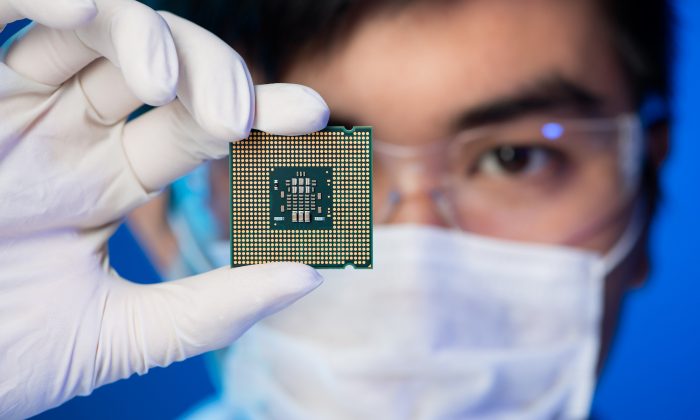Chip-Based Trust for the Digital Good
Trust is at the nexus of societal progress and the adoption rate of technology
by Terry Daly
Digital technologies are accelerating and transforming every aspect of society from business, finance and government to personal productivity, entertainment, education, health care and transportation. But toward what end? What is the critical factor in determining whether this transformation will result in a net good for society, and not simply for the advancement of technology and corporate profits? Trust – in the security of information in products, and in the use of digital products across the connected world – is at the nexus of societal progress and the pace of adoption of technology, determining the growth rate of the industry itself. Technology companies have a responsibility to society beyond delivering product innovation; they must deliver Digital Trust. The semiconductor industry, the foundation for innovation up and down the technology stack, bears a special responsibility for leadership in delivering Digital Trust.
At its core, digital technology is a combination of bits (the digits “0” and “1”) to represent words, numbers and images. This allows for the manipulation, compression, storage and transmission of voice, data, and video at lightning speed and very low cost. A complex ecosystem of data centers, networking and communications infrastructure and high-performance computers have evolved to deliver powerful platforms for companies to innovate and improve the quality of life for people worldwide, including a broad array of applications in fields of social media, e-commerce and the sharing economy. Think Amazon, Facebook, Uber, Google and Netflix.
But with progress comes risk and downside. There are many bad actors in society with the means, motive and opportunity to leverage digital technology for more nefarious goals. What is at stake? For starters, privacy of personal information (high visibility hacks of Yahoo and Equifax), economic security (ransomware attacks against hospitals, corporations and individuals), and trust in historic pillars of society (media and government – what news is real?). Going forward there are deep concerns regarding the security of critical infrastructure (power grids, the internet), highway safety (in the advent of autonomous vehicles), and defense and national security (“cyber” is the 4th dimension of warfare after land, sea, and air/space). Finally, imagine the future hack and intentional mis-classification of facial recognition inferences sourced from billions of camera-enabled devices leading to false charges against innocents. Who controls the AI code, and with what objectives? If consumers, businesses and governments lose trust, the promise of the connected world will languish, and the full potential of technology to improve the lives of people across the globe will not be realized.
So, my semiconductor industry colleagues ask: “What? Are you kidding me? You are laying the future of societal progress on The Digital Planet on us?” Yes.
Semiconductors are at the heart of the digital economy. For the uninitiated, semiconductors are the “chips” that: process and store data, voice and video in mobile phones, tablets and consumer devices; drive the network infrastructure central to the internet; power high performance computer platforms that crunch massive amounts of data in “the cloud”; provide sensor and processing capability to autonomous vehicles; and enable a wide variety of industrial, defense and aerospace applications. In 1965 Gordon Moore of Intel made the “observation” that the number of transistors in a dense integrated circuit would double approximately every two years. The industry made that a reality for over 50 years, as well as its corollary that chip performance would double every 18 months (due to more and faster transistors).

The technologists and innovators in the industry are a special breed of chemical, materials science, physics, computer science, software and electronics engineers. They operate in the world of nanometers (nm), a measure one-billionth of a meter. For calibration, a sheet of paper is about 100,000nm in thickness. A single strand of human DNA is 2.5nm in diameter. The diameter of an individual atom is in the range of .1-.5nm. The leading edge of semiconductor production in 2018 will be done at 7nm. In one leading edge semiconductor production step, a set of chemical reactions literally grow the layers of transistors one atom at a time. This type of manufacturing prowess, combined with equivalent strides in design automation and chip design, results in staggering capability. Nvidia’s latest graphics processor (GV 100 Volta) has a mind-boggling 21 billion transistors on the chip. The semiconductor community has arguably delivered innovation and solved challenges on a scale unmatched by any other industry.
With this track record of innovation and solving tough problems, why is there not a chip-based solution to the security necessary to engender Digital Trust? Good question.
The industry has been working on the challenge. Among the innovation in this domain are: encryption standards, methods and authorization protocols (e.g.; AES, RSA, ECC, “hardware root of trust”); a range of innovative biometric solutions; an Underwriter’s Lab Cybersecurity Assurance Program; the ability to prevent hackers from gaining access to embedded software code; and the creation of OpenFOG, an industry consortium to guide standards for secure, reliable networks between the cloud and intelligent endpoint devices. Arm, the microprocessor architecture company, has published a “Security Manifesto” as a call to action for the industry.
Yet despite all of this, as recently as January 2018 we have seen the revelations of Meltdown and Sceptre, the high-profile chip-level hardware bugs that allow attackers to access information from the memory of other programs. These defects were featured by the press most prominently with Intel processor designs, but also appear to impact AMD and Arm-based designs.
A full solution to digital trust and security must be an end-to-end solution, integrating all aspects of the digital value chain. This includes software, internet solutions, networking and communications, and hardware platforms across the spectrum from the smallest IoT device to the largest supercomputer. Service providers across this value chain and end users themselves (corporate, government and individual) share responsibility. The semiconductor industry might argue that it is only a “necessary but not sufficient” part of the solution. Perhaps. But this would not be acting in its vested self-interest. Semiconductor industry revenue in 2017 topped $412 billion, with compelling growth in its sights driven by killer applications and disruptive technologies such as artificial intelligence, IoT, virtual reality, autonomous/connected cars, big data, cryptocurrency and blockchain, among others. And these markets are largely incremental to the substantial scale of existing segments. The rate of industry growth will be a function of delivering TRUST. Governments should provide funding to accelerate innovation and legislate appropriate standards. But Digital Trust is primarily an industry responsibility.
Here is the challenge and opportunity for the semiconductor industry:
- Solve On-Chip Security – make chips hack-proof, but able to receive “Trusted Source” updates
- Embed security into the chip design and manufacturing processes, including IP and software
- Use a standards-based and platforms approach to enable rapid innovation
- Ensure global supply chain integrity from fab to assembly-and-test to system house to customer
- “QA the process” – provide customers assurances that chips are secure
- Be the proof point – apply solutions in the semiconductor industry first
Digital Trust, the central ingredient to advancing societal good in the digital economy, is at the nexus of societal progress and the rate of adoption of technology innovation. Delivering digital trust is in the vested self-interest of the semiconductor industry. Technology companies have a unique responsibility to society and the opportunity to make it happen. If the semiconductor industry can achieve 50 years of Moore’s Law. and design and manufacture at the atomic level, surely it is up to the challenge! Which company or industry organization will lead and deliver?
 Terry Daly is Senior Fellow at The Council on Emerging Market Enterprises, The Fletcher School of Law & Diplomacy. He retired after 33 years in the technology industry as senior vice president with GLOBALFOUNDRIES, a Silicon Valley-based semiconductor company. He holds a bachelors in engineering degree from the United States Military Academy at West Point and a masters in international relations degree from The Fletcher School, Tufts University in Boston.
Terry Daly is Senior Fellow at The Council on Emerging Market Enterprises, The Fletcher School of Law & Diplomacy. He retired after 33 years in the technology industry as senior vice president with GLOBALFOUNDRIES, a Silicon Valley-based semiconductor company. He holds a bachelors in engineering degree from the United States Military Academy at West Point and a masters in international relations degree from The Fletcher School, Tufts University in Boston.
